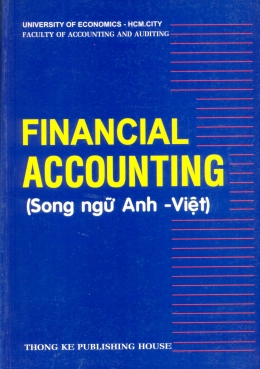Taisachpdf.net – Quyển sách Financial Accounting (Song Ngữ Anh – Việt) viết bởi Tác giả Nhiều tác giả và được phát hành ngày 09/2008 bởi Nxb Thống kê.
Financial Accounting (Song Ngữ Anh – Việt) viết về chủ đề Sách Giáo Trình Cao Đẳng – Đại Học và được bán với giá 168.000đ. Hãy mua sách để ủng hộ tác giả bạn nhé.
Bạn đang tìm: Financial Accounting (Song Ngữ Anh – Việt) PDF
Thông tin về sách
| Tác giả: | Nhiều tác giả |
| Nhà phát hành: | Nxb Thống kê |
| Nhà xuất bản: | |
| Ngày phát hành | 09/2008 |
| Định dạng |
Download ebook Financial Accounting (Song Ngữ Anh – Việt) pdf.

Bạn có thể tải sách Financial Accounting (Song Ngữ Anh – Việt) PDF tại đây.
Nội dung sách Financial Accounting (Song Ngữ Anh – Việt).
Financial Accounting (Song Ngữ Anh – Việt)
CONTENTS: CHAPTER 1 ACCOUNTING ENVIRONMENT 1.1 What is Accounting and Accounting Environment. 1.2 The Users of Accounting Information. 1.3 Environmental Impact of Accounting Organizations. 1.4 Developing Accounting Standards. 1.5 Generally Accepted Accounting Principles (Gaap) CHAPTER 2 The Basic Accounting model 2.1 Accounting as an Information System 2.1.1 Financial Position and the Accounting Equation 2.1.2 Effects of Business Transactions on Financial Position 2.1.3 Communications through Financial Statements 2.2 Double-Entry System. 2.2.1 Recognition, Valuation, and Classification. 2.2.2 Account and Double-Entry System. 2.2.3 Recording and Posting Transactions. 2.2.4 Trial Balance 2.3 Measuring Business Income and Adjusting Process 2.3.1 Measuring Issues 2.3.2 Adjusting Process 2.3.3 Adjusted Trial Balance (ATB) 2.4 Completing the Accounting Cycle 2.4.1 Overview of the Accounting Cycle 2.4.2 Closing Entries 2.4.3 Reversing Entries – the Optional First Step in the Next Accounting Period. 40 2.4.4 The worksheet – an accountant’s tool CHAPTER 3 Accounting for Merchandising Operations 3.1 Income Statement for A Merchandising Concern 3.2 Accounting for Revenues from Sales 3.2.1 Gross Sales 3.2.2 Sales Returns and Allowances 3.2.3 Sales Discounts 3.3 Accounting for Cost of Goods Sold 3.3.1 Net Purchases 3.3.2 Accounting for Purchases Returns and Allowances 3.3.3 Freight In 3.4 Accounting for Merchandise Inventory 3.4.1 Periodic Inventory Method 3.4.2 Perpetual Inventory Method 3.5 Accounting for Operating Expenses 3.6 The Work Sheet for a Merchandising Concern 3.6.1 Prepare the Work Sheet under Perpetual Inventory System 3.6.2 Prepare the Work Sheet under Periodic Inventory System CHAPTER 4 ACCOUNTING FOR CURRENT ASSETS 4.1 Accounting for Cash & Cash Equipvalent 4.1.1 Internal Control for Cash 4.1.2 Petty Cash Fund 4.1.2.1 Establishing the Fund 4.1.2.2 Making Payments from the Fund 4.1.2.3 Reimbursing the Fund 4.2 Accounting for Short Term Investments 4.2.1 Classification of Short Term Investments 4.2.2 Held-To-Maturity Securities 4.2.3 Trading Securities 4.2.4 Gains and Losses from Sale of Investments in Securities 4.2.5 Investment on Bonds between Interest Dates 4.3 Accounting for Receivables & Bad Debts 4.3.1 Accounting for Receivables and Bad Debts 4.3.2 Estimating Uncollectible Accounts Expenses 4.3.2.1 Percentage of Net Sales Method 4.3.2.2 Accounts Receivable Ageing Method 4.3.3 Writing off an Uncollectible Accounts 4.3.4 Recovery of an Accounts Receivable Written Off 4.4 Accounting for Notes Receivable 4.4.1 Notes Receivable 4.4.1.1 Receipt of Notes Receivable 4.4.1.2 Calculations for Notes Receivable 4.4.2 Accounting for Notes Receivable 4.4.2.1 Recording Collection on a Note Receivable 4.4.2.2 Recording a Dishonored Note Receivable 4.4.2.3 Discounting a Note 4.4.2.4 End of Period Adjustment for Interest Income 4.5 Pricing the Inventories 4.5.1 Importance of an Accurate Valuation of Inventory to the Financial Statements 4.5.2 Methods of Pricing Inventory at Cost 4.5.2.1 Perpetual Inventory System 4.5.2.2 Periodic Inventory System 4.5.3 Valuing Inventory at the Lower of Cost and Market (LCM) 4.5.3.1 Item-By-Item Method 4.5.3.2 Major Category Method 4.5.4. Valuing Inventory by Estimation 4.5.4.1 Retail Method of Inventory Estimation 4.5.4.2 Gross Profit Method CHAPTER 5 ACCOUNTING FOR LONG-TERM ASSETS 5.1. Characteristic of Long-Term Assets 5.2 Property, Plant, and Equipment 5.2.1 Acquisition Cost of Property, Plant, and Equipment 5.2.2 Accounting for Depreciation 5.2.2.1 Depreciation Methods 5.2.2.2 Depreciation Entry 5.2.2.3 Partial – Year Depreciation 5.2.2.4 Revision of Depreciation Rates 5.2.3 Ordinary and Extraordinary Repairs 5.2.4 Disposal of Depreciable Assets 5.3 Accounting for Natural Resources 5.4 Accounting for Intangible Assets 5.4.1 General of the Intangible Assets 5.4.2 Classification of Intangible Assets 5.5 Control of Plant Assets 5.6 Long-Term Investments 5.6.1 Long-Term Investment in Stocks 5.6.1.1 Cost Method for Short-term Investments and for Long-Term Investments of Less Than 20% 5.6.1.2 The Equity Method for Long-Term Investments of Between 20% and 50% 5.6.2 Long-Term Investment in Bonds.Mời bạn đón đọc.
Review sách Financial Accounting (Song Ngữ Anh – Việt).
Đang cập nhật…
Mua sách Financial Accounting (Song Ngữ Anh – Việt) bản quyền ở đâu.
Quyển sách Financial Accounting (Song Ngữ Anh – Việt) hiện được bán với giá 168.000đ, bạn có thể mua trược tiếp sách tại đây.
Tìm kiếm liên quan
Download Financial Accounting (Song Ngữ Anh – Việt) PDF
Financial Accounting (Song Ngữ Anh – Việt) Tác giả Nhiều tác giả PDF
Tải sách Financial Accounting (Song Ngữ Anh – Việt) ebook MOBI
Financial Accounting (Song Ngữ Anh – Việt) EPUB
Financial Accounting (Song Ngữ Anh – Việt) full
Financial Accounting (Song Ngữ Anh – Việt) đọc online
Ngày xuất bản: February 8, 2022 @ 12:58 am

![[Tải sách] Bí Mật Thành Công Của Những Người Bán Hàng Xuất Sắc PDF.](https://taisachpdf.net/wp-content/uploads/2022/01/p91890mbia_1-100x100.jpg)
![[Tải sách] Thay Đổi Hay Là Chết PDF.](https://taisachpdf.net/wp-content/uploads/2022/01/p91885mthay_doi_hay_chet-100x100.jpg)
![[Tải sách] Người Bán Hàng Giỏi Phải Bán Mình Trước PDF.](https://taisachpdf.net/wp-content/uploads/2022/01/p91884mban_minh-100x100.jpg)
![[Tải sách] D. Trump – Nghệ Thuật Đàm Phán PDF.](https://taisachpdf.net/wp-content/uploads/2022/02/p94893mimage_195509_1_49918-100x100.jpg)
![[Tải sách] Tổ Chức Học Tập – Bí Mật Kiến Tạo Lợi Thế Cạnh Tranh Bền Vững Cho Doanh Nghiệp PDF.](https://taisachpdf.net/wp-content/uploads/2022/01/p91877m1-100x100.png)
![[Tải sách] Triệu Phú Môi Giới Bất Động Sản PDF.](https://taisachpdf.net/wp-content/uploads/2022/01/p91882mbia_truoc_1-100x100.jpg)